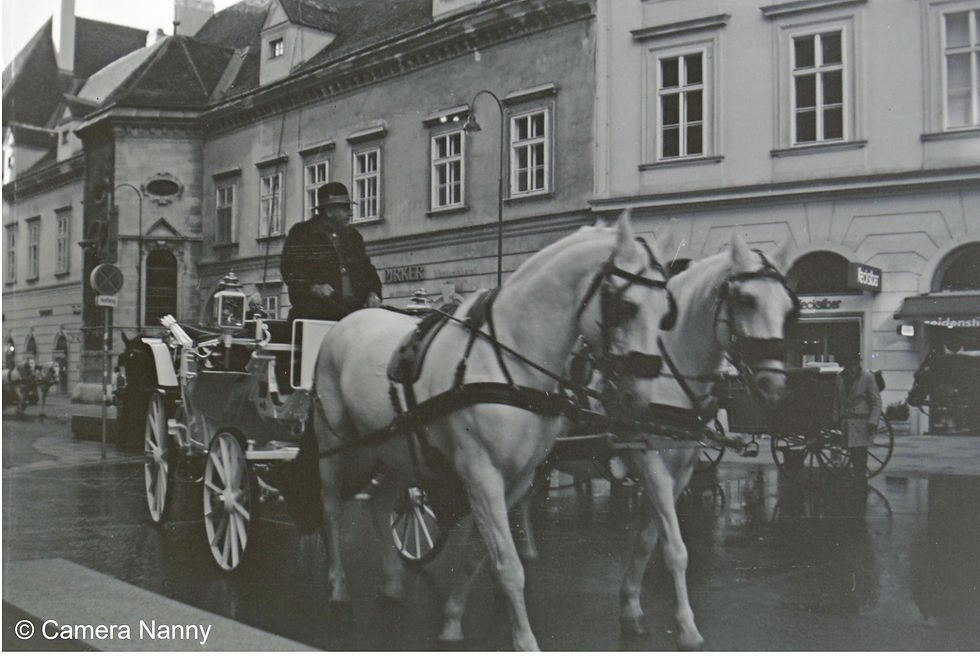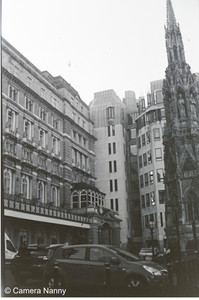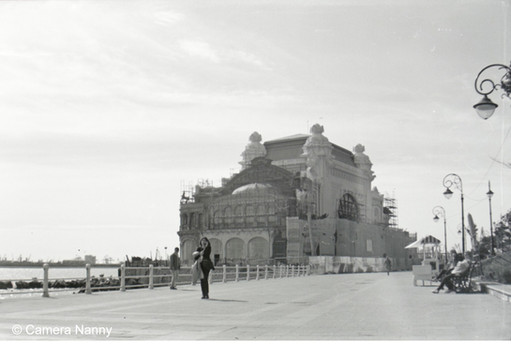11. London to Istanbul with a World War 1 camera
- Camera Nanny

- Feb 2, 2023
- 7 min read

The Orient Express, a luxury train across Europe to the gateway to Asia, was the brainchild of 19th century Belgian businessman Georges Nagelmackers. The first journey from Paris to Constantinople (now Istanbul) took place in 1883. There were several route changes and additions due to two world wars, problems in the Balkans and the lack or addition of railway track.

The Orient Express, as such, no longer exists, but you can still complete the journey by modern trains. In 2022 we found a timetable from 1913 taking a route to Constanta on the Black Sea, where passengers used to transfer to a boat for the final leg. The alternative route via Belgrade is currently closed to passengers, but it's possible to pick up this route again at Sofia in Bulgaria.
So we hatched a plan to recreate this journey all the way from London to Istanbul via Constanta and Sofia, sticking as faithfully as possible to the 1913 route and recording the journey with my WW1 Vest Pocket Kodak Camera,
Frankly, it's a totally ridiculous idea.
Yet one October morning we set off from London's Charing Cross, blissfully unaware that Day 1 was about to be the most difficult and stressful of the whole trip.
The 'old' route trundles along to Dover where it's a short pleasant walk along the prom to the docks. And that's where the problem starts, because the ferry companies don't want foot passengers, they want vehicles. So foot passengers have to arrive 90 minutes before departure, hang around for ages and then be taken to the ferry by bus where you hang around even more.

Then at Calais there is more hanging around on the boat long after the cars have disembarked, waiting for another bus to take you to the ferry terminal, only to discover that the last bus to the town has long since departed and the taxis are all otherwise engaged. After an hour waiting for a taxi, we set off on the 3km walk into town, and after 2km our lovely B&B owner came and picked us up. Hurrah, after almost 10 hours we've made it to Calais. Wow, at this rate this could take a very long time indeed!
The next morning we're on our way properly, taking the original route to Paris via Boulogne and Amiens, which turns out to be an interesting town with a connection to Jules Verne. He wrote the classic novels 'Around the World in 80 Days' and 'Journey to the Centre of the Earth', which seems quite apt after yesterday. We have an afternoon in Paris, a good opportunity to test the camera around some of the sights. I jostle for position among the iPhones and Nikons, attracting a few strange looks.
After a night in Paris we're finally heading east via Strasbourg, Stuttgart and Munich. There is a fast line to Strasbourg which takes less than 2 hours. But it's not authentic enough to the Orient Express route, so we pootle along the slow line getting to Strasbourg after 5 hours. You can see why you might need a lot of time to travel like this. It's a good job we're retired!

Another night in Munich and then we're off to Vienna, where we have a couple of hours to spare before our sleeper train, the first of two on this epic journey. There's just time to photograph a horse and carriage near the iconic St Stephen's Cathedral.
Then we head to the station to find our sleeping compartment.
There is one sleeper to Bucharest which leaves Vienna each evening. In the middle of the night the train divides somewhere in Romania, after which some carriages continue to Bucharest via a northerly route and some also continue to Bucharest via a slower, meandering, southerly route. To ensure we are in the carriages which take the southern route, we've booked our ticket to Videle, a small station just before Bucharest.
We wake to a beautiful sunrise close to the Serbian border and chug sedately towards the Romanian capital, arriving in the late afternoon. The next day we get stuck in a queue trying to buy mandatory seat reservations for a day trip to Constanta on the Black Sea. Eventually giving up, we run to the platform and persuade the conductor to let us board what turns out to be an almost empty train. This is the last part of the train journey for the Orient Express passengers in 1913. From Constanta they had to spend the final 24 hours on a boat to reach Constantinople. That option last sailed many years ago, so we have to continue by a different route.
Constanta is an interesting small town with a beach, Roman remains and a fabulous casino from the 1880s, currently undergoing renovation. Having brought the Vest Pocket Kodak all this way, I have to record the event of course, and there's a convenient abandoned picnic table which doubles as a tripod.
Bucharest itself is a thought-provoking city. Evidence of its communist past is everywhere, with huge government buildings built at enormous expense whilst many residents lived in very poor conditions. But there are also beautiful historical buildings, including orthodox churches and monasteries which house stunning wall paintings.
After a couple of days it's time to move on again. First we retrace our steps west but take a slight diversion via Pitesti for completeness, a 5 hour section our sleeper bypassed. The other Orient Express route in 1913, determined by the day of departure from Paris, was via Belgrade in Serbia and then Sofia and Dimitrovgrad in Bulgaria. The section through Serbia is currently closed so we head for Sofia to pick up the route again. The journey runs alongside a river where we can see Serbia on the opposite bank, before turning south into Bulgaria. We pass through a spectacular gorge for the last 2 hours to Sofia, before continuing on to Plovdiv, an ancient city previously called Philippopolis - Now that's what I call a proper city name!

Plovdiv is definitely worth a few days,
and whilst there we take a local train journey of 3 hours to the charming village of Koprivshtitsa, known for its historic and authentic Bulgarian architecture. Suddenly my WW1 Vest Pocket Kodak doesn't seem so out of place. The bus from the station turns out to be a man and a van, which carries us steeply quite a long way uphill to an altitude of around 1000m. It's only when we ask where the return 'bus' goes from that we discover (with our limited Bulgarian)... there isn't one at the right time for our train. But the kind driver agrees to come back for us anyway and is as good as his word. Tip: learn the words for 'please' and 'thank you' in every language you might need. They might save you from being stranded one day!
It's a new day and a new queue at the station, this time to book a sleeper for the final section of our journey to Istanbul, which can only be done in person in Bulgaria. There are a lot of 'no', 'not possible' and pursed lips until we manage to make it clear we don't want to travel tonight. Then suddenly it's all smiles and 'no problem'. A few days later, after returning to Sofia, we're met by the cheerful Turkish sleeping car conductor, who shows us proudly to our compartment complete with desk and mini fridge. It's a shame really, because an hour into the journey it becomes obvious that the electric supply doesn't work, and we have to sit in complete darkness for a while. Eventually we get moved to another sleeping compartment and can go to bed.
But this is the Balkans. And when you cross into Turkey in the middle of the night, the border police are not content with passengers peering sleepily out of their bunk trying to look like a passport photo. Everyone, literally every man, woman and child, has to get off the train and queue up in a draughty station building at 3am to see the border police, who sit comfortably behind a grille with a coffee and cigarette. Shuffle forwards. Slowly. Get to the grille. Hand over your passport. Watch the man frown, turn the passport this way and that, frown again. Disappear with said passport, eek! After a tense few minutes, man returns, frowns again, stamps the passport vigorously and hands it back. With an extra frown just for good measure. We're in.

The sleeper train from Bulgaria to Turkey is frequently delayed by several hours, so we've done quite well to arrive at Halkali station just outside Istanbul only 3 hours late. The last little bit is a fast metro train which whisks us into the main Sirkeci station, where the Orient Express passengers also used to arrive. There remains evidence of the original architecture, though it is difficult to capture with my Vest Pocket Kodak as I have to make a guess at exposure and have no tripod.

Having made it all the way from London to Istanbul following the 1913 Orient Express route as closely as possible, there is one more place we feel we need to visit. The city of Istanbul spans two continents, Europe and Asia, divided by a body of water known as the Bosphorus Strait. There are several crossing points by road bridge, underground rail and boat. We decide on the authentic experience of a boat across the Strait, which takes us close to Haydarpasa station where trains used to depart for cities in Persia (Iran) and Mesopotamia (Iraq).
Sadly, the station today is in a permanent state of renovation. The whole area is blocked off to visitors by fencing and an honourable security guard, who doesn't want to lose his job by letting strange tourists through. But lots of smiles, a conversation about our epic journey from London to Istanbul just to see his beautiful, historic station and a sneaky look at my WW1 Vest Pocket Kodak finally win over the guard. We follow his brisk walk through the barrier and past the building site to a vantage point, where I succeed in taking a couple of quick photos before he changes his mind.
So we finally made it to the end of this amazing journey with a WW1 camera. But it's not quite the end of our trip. Before we left England we researched the Orient Express, its history, routes across Europe, high society passengers, stories and legends. The crime writer Agatha Christie came to Istanbul many times, where she stayed at the grand Pera Palace Hotel which was built in the 1890s for arriving Orient Express passengers who demanded the highest standards. We can't quite afford to stay in one of the sumptuous suites, but we can eat afternoon tea in the fabulous Kubbeli Lounge. It's an obvious venue for a photo shoot with my Vest Pocket Kodak. Whilst setting up a photo, we're approached by a curious, well-dressed man who turns out to be a director of the Hotel. He's interested in the Vest Pocket Kodak and intrigued by our epic journey, resulting in him giving us his business card, a 'free pass' to see the Agatha Christie floor. We're allowed to roam at leisure, perusing artefacts from her stays and the Orient Express era. Wow, what an experience. What a journey. What a camera!








































Comments